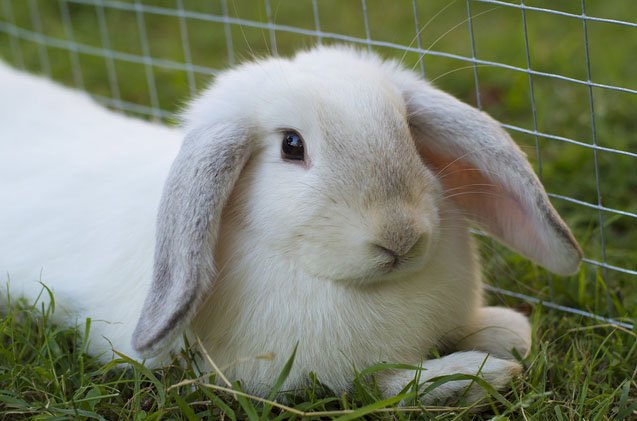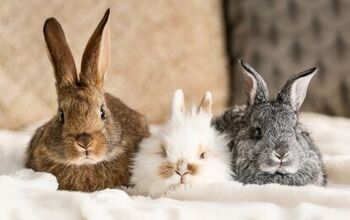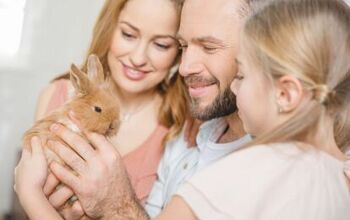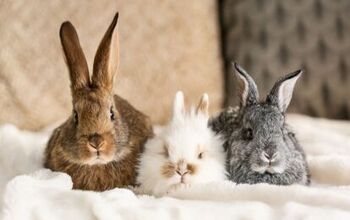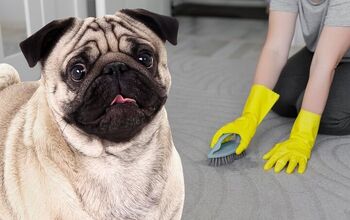Mini Lop


About Mini Lop
Mini Lop Breed History/Origin
Some people think that dogs are the only pets who have a diverse world of breeds to boast with – canines of all shapes, colors, and sizes to make any family happy. Well, that’s definitely not the case, as many other popular pets have been bred selectively to produce all types of animals to suit different lifestyles and families, including rabbits. From giant breeds created to be docile and calm, to petite dwarf bunnies that make exceptional companions for owners of all ages to show bunnies with prized fur or striking appearance, there is a rabbit breed to match anyone’s preferences.
In other words, these remarkably cute and desirable little pets have been taking the world by storm for decades and none of them are more popular or beloved than the Mini Lop. This breed was developed with the sole intention of creating a perfect companion or show rabbit, and it really shows, both through their cute appearance and loveable temperament. With their irresistible looks and plenty of positive character traits, they make great pets in so many ways. And in the end, one thing remains certain – if you like cute, cuddly, and infinitely fluffy, you will adore a Mini Lop rabbit.
The Mini Lop originated in Germany when a German Lop was bred with a small Chinchilla rabbit. The newly developed breed became known as the Klein Widder or “Little hanging ear.” Due to the distinct parent breeds, the Mini Lop has quite a unique look, mixing that fluffiness and rounded look of a Chinchilla, with the rabbit features of a German Lop. Besides the Klein Widder nickname, these rabbits have many names, but no matter what you choose to call them, these little darlings are certain to melt your heart. The soft and cuddly looks are hard to resist, as is their personality.
In the early ’70s, a Californian breeder named Bob Herschbach spotted this newly developed breed at a show in Essen, Germany, and consequently brought a trio of them to the United States. He began breeding them and crossing the breed with a Standard Chinchilla rabbit. The first rabbit of this kind was presented to the American Breeder’s Association (ARBA) with the name “Klein Widder,” but the name changed to the Mini Lop in 1974. The Mini Lop was successfully accepted into the ARBA later in 1980 by a man named Herby Dyke. Ever since then, bunny lovers everywhere have been seeking out Mini Lops to fill the rabbit sized holes in their hearts. Their “rise to fame” amongst show rabbit breeds was nothing short of stellar, and the Mini Lop soon became a favorite of many.
The Mini Lop makes an excellent pet for families with children and seniors.
Overall Description
You might not find the words “fuzzy basketball with a head” in the ARBA Standard of Perfection for the Mini Lop, but it really does sum up how an ideal representative of what this breed should look like. The Mini Lop has a compact body type and is among the smaller rabbit breeds. An adult Mini Lop should weigh anywhere from 3 to 6 pounds, with the does being smaller than bucks. Regardless of their ultimate size, they all share a signature rounded body type: little furry balls of joy. Their legs are short and stocky, as well as their tails, which also contributes to their fluffy ball look, and of course, only makes them more irresistible for potential owners.
When it comes to the official standard for showing Mini Lops, an overall rounded appearance is not enough to describe them – the criteria are much more precise in the world of show bunnies. According to the standard, their body should be massive and thickest, despite its relatively small size. It is heavily-muscled and well-rounded, and dewlap is permitted for the females of the species. The neck should be as short as possible, with the broad head sitting close to their compact bodies (often it appears like they don’t have a neck at all). As the name of the breed suggests, the rounded and well-furred ears sit lopping vertically to the sides of the head.
Coat
Mini Lops have a luxurious soft, medium-length rollback coat. However, despite their gorgeous fur, they do not require much care in the grooming department. Especially when compared to wooly breeds such as the English Angora, which is one of the breeds considered to be high maintenance because of its thick luscious mane. Weekly brushing is all that’s necessary to keep their coat soft, plush, and tangle free. This will also help remove dead hair and reduce shedding, which is great both because it means that there’ll be less bunny hair around your furniture and floors, but also because it will reduce the possibility of your rabbit ingesting his hair and experiencing blockage. Some owners may wish to increase the amount of grooming to twice a week during molting periods, which usually occur twice a year. That could be a wise choice just to be safe.
In addition to helping keep rabbit hair off your furniture, frequent brushing during periods of increased shedding can also protect your pet’s health. As avid self-groomers, rabbits can ingest a lot of their own hair by accident, which can seriously endanger them if a hairball forms in the intestine. By helping them get rid of loose hair with brushing, you minimize the possibility of your pet rabbit getting sick. So, it might be wise to monitor your Mini Lop’s molting seasons to avoid any unnecessary health issues.
If your Mini Lop is a proud show rabbit, you need to remember that their coat needs to meet certain standards that are expected for the breed. The ideal Mini Lop coat should be quite thick and dense, sporting that iconic sheen, overall looking glossy and lustrous. It also has to be medium in length with a good roll back. Coat that is extremely short, too long, thin, silky, or harsh, is seen as a fault on shows.
Colors
The ARBA accepts a range of colors and markings for the Mini Lop. There are seven different color groups that are common with this breed: agouti, broken, pointed white, self, shaded, ticked, and wide band. These categorizations might not mean much if you’re new to the world of rabbits, but they do make it clear that there’s a pattern or a shade of the Mini Lop to match anyone’s preference. Some of the most common colors spotted in Mini Lops are – amongst others – Chocolate, Ruby-eyed white, Opal, Lynx, White, Black, Chestnut Agouti, Chinchilla, Blue-eyed white, Lilac, Orange, Blue, and Tri Color. Such variation is not often spotted in the world of pet rabbits, and allows for plenty of diversity in shows as well as for people that are picking out a pet.
Whether you want a tri-colored, solid black, or anything in between, you’ll be able to find it! Yet another reason why the Mini Lop has become such a beloved option for rabbit owners. They aren’t just adorable, they are practically customizable.
Mini Lops should be out of their enclosures to play and create a lasting bond with their human handlers.
Care Requirements
Like all rabbits, Mini Lops need an adequate enclosure to live their lives, eat, sleep, etc. As most rabbits, Mini Lops can live either inside the house or outside, provided that all of their needs are met and that their housing is adequate. This means, in terms of outdoor enclosures, that their hutch should be placed somewhere away from the harsh elements, such as strong winds, biting cold, or scorching sun in the summer months. Rabbits are very sensitive to extreme weather conditions, so if you keep them outside, you need to be prepared to find a perfect location – sometimes, as a compromise, people place their bunny’s hutch in the garage or similar places when they are not able to keep them inside the house. Their outdoor hutch should be raised and have enough space for the rabbit to stretch their legs out comfortably. It should also have a ramp that lowers to the bottom of their fenced enclosure so they can feel some grass and ground beneath their feet. The bottom should be cushioned with bedding if it’s made from wire – never leave rabbits on wire cage bottoms because of the possibility for sore hocks – and cleaned regularly. Of course, their hutch should also have their food, water, and toys inside.
On the other hand, indoor rabbits should have a wire enclosure that also allows them enough space to stretch out and of course, a corner to do their business. Their bedding should be spot-cleaned every day so they can lay down on clean and soft bedding. It should be completely replenished every week. Health issues can arise surprisingly quickly if rabbit owners don’t pay careful attention to the cleanliness of their rabbits home. It is a responsibility that needs to be taken quite seriously. Needless to say, though, a rabbit shouldn’t be kept inside their enclosure exclusively – they need to be able to freely roam around and explore outside their cage. When you keep your pet indoors, that means you will also have to rabbit proof the area they will have access to, both for their safety and to protect your furniture, cables, etc. from damage.
Thankfully, the Mini Lop’s diet does not differ from any other rabbit breed. That means they require a diet consisting of 70 percent good-quality hay such as orchard hay or timothy hay (the occasional alfalfa grass snack would also be good for their overall health). The rest of the diet should be a nice balance of fruits, leafy greens, vegetables, and pellets. Like hay, there are plenty types of pellets available on the market, some with higher protein content than others. While lower quality pellets can cost quite a bit less, it’s really not worth it if you care about the health and happiness of your pet. Remember that a balanced diet is key to good health. Avoid processed and unhealthy foods, and things that rabbits are not meant to eat. It can be the most important error to avoid when talking about basic rabbit care.
It’s also a good idea to be aware of what kind of fruits, leafy greens, and vegetables you have in your home because some are rabbit-safe and others are absolutely not. In fact, most leafy greens are unsafe as they can cause digestive issues, especially if you feed your rabbit a large amount of it. Feed your rabbit greens that are high in fiber and nutrients (such as romaine lettuce) and be aware of what kind of fruits you’re feeding (nothing too high in sugar). Your rabbit might seem to enjoy other greens and fruits more, but that doesn’t mean they are the healthiest choice. You know, just like humans.
Mini Lops should be allowed out of their enclosures to play and create a lasting bond with their human handlers as often as possible. Remember to bunny-proof any room that your indoor rabbit resides in, as they will often chew on anything they deem a toy. That could be a harmless (but pricey) mistake or something far more unfortunate. Should you wish to provide your rabbit with some outdoor fun, remember to place them in a fenced portion of your yard (there are a few rabbit proof fences readily available online or at pet stores) and always have an adult present to supervise and shield your rabbit from any dangers (such as racoons, dogs, etc). Indoor rabbits love to have outdoor adventures, but they won’t be nearly as cautious as their humans might prefer when left to their own devices. So be careful.
Health
Mini Lops are not susceptible to any particular disease, but there are a few health concerns that every pet rabbit owner needs to be aware of. With their needs met and proper living conditions provided, there are thankfully not many problems that these bunnies face. Please keep that in mind and make sure to provide the best possible life to your pet. It’s obvious advice, but there are sadly far too many pet owners out there don’t take their responsibilities seriously.
First and foremost, if a rabbit goes outside, they are very susceptible to flystrike, a condition in which flies lay their eggs on soiled patches of fur (usually around their rear). When the eggs hatch, their main source of nutrition is the rabbit itself and they will start to devour the rabbit from the inside out, causing excruciating pain. Symptoms include seizures, loss of motion (listlessness) and skin irritations. These parasites are something out of a horror movie and you absolutely do not want to be a supporting character in that nightmare.
All rabbits are avid groomers and will ingest a lot of their own hair while cleaning themselves- similar to cats. Unlike felines, though, rabbits can’t vomit, so any hairballs that form in the intestine can become stuck and cause blockage or GI stasis. The preventive includes regular brushing and feeding a lot of roughage. This condition can be life-threatening if not noticed on time, so pay attention to common signs. No poop or very little of it, lethargy ,and loss of appetite all point to hairball blockage. If you notice any of these signs, rush your pet to a veterinarian with experience in small animals. This problem is common enough to be easily rectified by an experienced vet, but timing is crucial. So keep and eye on your Mini Lop and act quickly if you notice any of these warning signs.
Additionally, always be sure to check your rabbit’s teeth, as they continuously grow throughout their entire lives and are usually worn down by a high-hay diet. If their teeth are overgrown, they may pierce their jaw and/or faces, which also causes a lot of pain and limits your rabbit’s ability to eat. So make sure that both you and your vet monitor their teeth growth, especially later in life.
While considered one of their trademarks, the floppy ears of the Mini Lop rabbit are prone to infections, which means that bacteria can fester easily if they are not cleaned properly. Be sure to check for grime and dirt regularly and routinely clean your pet’s ears to keep them spick and span and prevent any trouble.
Also, be sure to also carefully inspect your rabbit’s ears for ear mites. These parasites easily infect rabbits in direct contact with a bunny that’s already infested, so make sure to take all of your pets to the vet if you notice even one of them displaying the signs such as ear scratching, head shaking or anything odd about appearance of their ears. This problem can also get out of hand very quickly, so getting him to a vet soon after noticing any warning signs is quite important.
Socialization with people is important. A bunny that spends all their time in an enclosure without being given much attention or space to roam is a neglected pet. They develop unhealthy habits, and can be prone to stress and apathy. Of course, lack of exercise and outdoor time is a major inhibiting factor too. So, once more, it is key to allow your Mini Lop out of the enclosure so they can create a bond with you and other people around them, to experience the outdoors and live a happy and fulfilling bunny life.
The Mini Lop is often described as being a “basketball with a head.”
Temperament/Behavior
These medium-sized rabbits are known to be the cuddliest pet rabbits around and are often described as looking like teddy bears because of their adorable looks and affectionate nature. True to their nicknames, they are indeed great pets for children to pick up, and more than happy to be petted from head to little fuzzy tail! Like most rabbits, their personalities bloom when they are given plenty of time to be out of their enclosures where they can safely roam around their rabbit-proof room or outside in a fenced portion of the yard. Your rabbit may also benefit from having a few toys to nibble on and play with. This can be as simple as an empty toilet paper roll or as complex as a mentally stimulating rabbit-safe toy from your local pet shop. Rabbits will surprisingly love toys, especially the ones that give them a “problem” to solve. It stimulates their little bunny brains and provides hours of fun on end!
Because of their sweet disposition, Mini Lops make excellent pets not only for families with children (both younger or older), but also for couples, singles, and seniors who are looking for a cuddly companion. It’s hard to find anyone who wouldn’t fall in love with one if these beautiful little bunnies. Still, make sure that your kids are well aware of how delicate a pet this can be. Although it is endlessly cute and cuddly, that is no reason why a rabbit should be squished, picked up, and smothered for hours on end. They won’t enjoy that one bit. Also, make sure that you’re not introducing a Mini Lop into a chaotic environment. Too many people and a lot of noise can put a bunny under a lot of stress, especially if they are in the center of attention. And excess stress won’t do them any good. In fact, it can cause a lot of problems.
Most rabbits are a little more difficult to train than the common house cat or dog, however it is not impossible. Litter training is possible with lots of patience, rewards, and a few well-placed litter boxes around the house. Teaching your Mini Lop stop, come or perform other common commands and tricks will come with time and plenty of repetition. A great help with training is positive reinforcement. Rabbits get the task-reward system too! Simple tricks and obeyed commands should be rewarded with tasty little bites or treats. In no time, the rabbit will connect the dots and obey a command – simply because they know a treat is on the way. With just a little bit of patience and time, you can train them to use a litterbox, stop nibbling things that are not for nibbling, and not to venture outside.
The ideal environment is a loving family household with older children that know how to care for a pet. Nevertheless, while a Mini Lop is a friendly and loving pet, it won’t hesitate to show its “angrier” side as well. Of course, you won’t be able to take them seriously due to their immensely cute looks, but hey – it is what it is. A Mini Lop might show displeasure by vigorously stamping their hind foot. This happens for example when strangers happen to invade their place, or some daily routine is not met. An occasional bite or nibble is also not out of the ordinary. A particularly temperamental, afraid, or stressed out bunny might chomp down onto an intruding finger or something similar. Of course, making sure that the surroundings are reasonably calm and without harm will make your bunny as calm and cool as can be.
Also, remember that a Mini Lop pet will need plenty of time outside. Rabbits naturally crave open air and grassy environments to play in and “exercise”. A pet rabbit that is often cooped up indoors or in a cramped environment can develop unhealthy habits and a despondent mood. However, when you take your bunny outside for playtime and some fresh air, it is crucial to make sure that they are safely enclosed and protected from potential predators- such as birds of prey or neighborhood cats and dogs. To that end, the best solution for a Mini Lop is a fenced-in yard. If you have a nice patch of greenery with a solid fence all around, that would be ideal for your little bunny friend. That way they can enjoy a natural, invigorating environment, without you fearing they’ll flee or get hurt. And if you don’t have a yard, don’t worry as there are many safe ways to provide outside time to a rabbit. There are special leashes that allow you to keep everything in control, or you can even find a special portable pen! Both will allow you to take your bunny to parks and other open spaces, without worrying about the traffic, predators, or similar issues.
Photo credit: Life on White/Bigstock; bobbiesnaps/Bigstock
We are committed to finding, researching, and recommending the best products. We earn commissions from purchases you make using the retail links in our product reviews. Learn more about how this works.

More by Diana Faria





